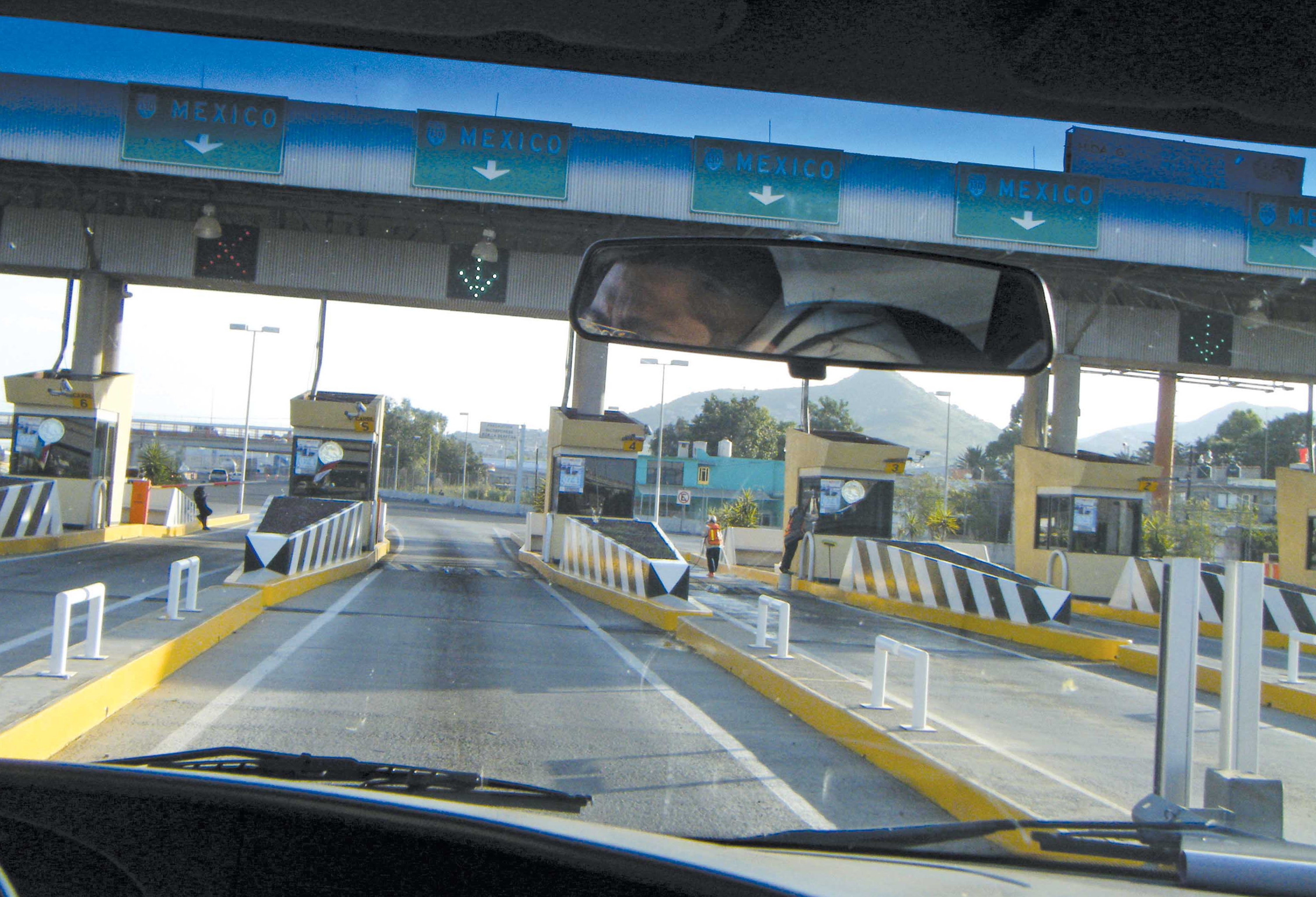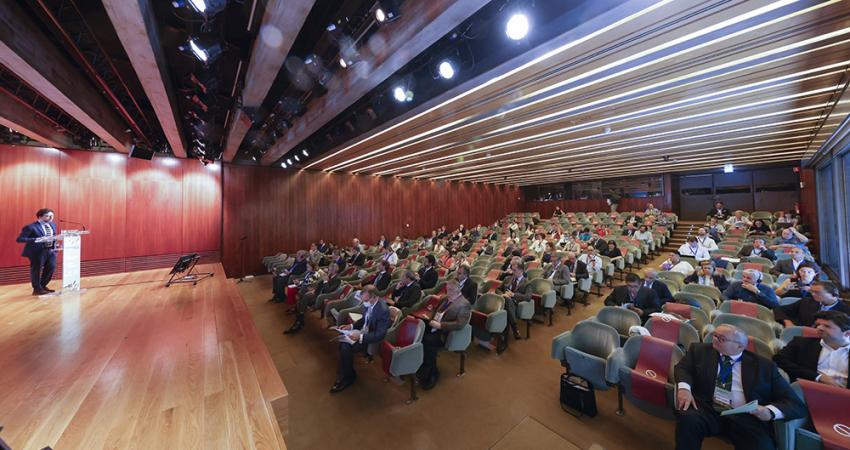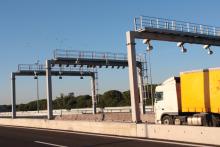Mobility pricing and electronic tolling is the future, delegates to a recent ASECAP Study Days conference, reports Geoff Hadwick at the Lisbon event.
The international road tolling industry is failing to make its case and the sector is losing out to other social and political lobby groups. As a result, “tolling is still on the sidelines”, according to the head of the Washington-based International Bridge, Tunnel and Turnpike Association.
IBTTA chief executive Pat Jones issued his stark warning at the

Road tolling is used extensively across Latin America
Mobility pricing and electronic tolling is the future, delegates to a recent ASECAP Study Days conference, reports Geoff Hadwick at the Lisbon event.
The international road tolling industry is failing to make its case and the sector is losing out to other social and political lobby groups. As a result, “tolling is still on the sidelines”, according to the head of the Washington-based2764 International Bridge, Tunnel and Turnpike Association.
IBTTA chief executive Pat Jones issued his stark warning at the recent1103 ASECAP Days conference in the Portuguese capital Lisbon. “We may well have a political and business environment that is friendly towards tolling,” he said. “But have we really made any progress in recent years? Yes … some. But not enough.”
Other lobby groups with extremely controversial agenda have achieved better results, such as the gay and lesbian movement’ campaign for acceptance of same-sex marriages, Jones said. Why, he asked, has the tolling industry has progressed so poorly?
“The coach has us in the playing squad, for sure, but we are still on the bench. Is that because the other players are better or because there is a cultural bias against us? Or is it because our style of play is unusual?” Jones said the tolling industry must be much more persuasive and find new ways to galvanise politicians into action.
It’s an important point, agreed Kallistratos Dionelis, general secretary of ASECAP -- Association Europeenne des Concessionaires d’Autoroutes et d’Ouvrages a Peages -- the leading European professional association for the operators of tolled motorways, bridges and tunnels. “We need to say to the European Commission to stop dreaming. We need action and we need it now,” he said in an interview with ITS International magazine, a sister publication of World Highways.
Dionelis spoke for virtually all of the presenters at the meeting. “It’s all very well having a vision, but if all you ever do is have visions you need to go and see an eye doctor.” He wants an EU-wide “consistent”, properly enforced and “inter-operable” tolling scheme as soon as possible.
Josef Czako: Four-point Plan
• commission, via ASECAP’s members, an analysis of the socio-economic benefits of mobility pricing looking at mobility pricing within existing and future tolling regimes;
• develop an ASECAP/European mobility pricing policy and industry-wide position;
• initiate discussions on mobility pricing with all EU stakeholders;
• encourage new concessions including charging schemes, especially for private car tollingAs the general secretary he is feeling increasingly frustrated over the EU decision making process, especially when compared to that of the more centralised US federal government. Europe’s political landscape may well be “diverse and fractured”, he conceded, but there is a deepening sense of unease over the tolling industry’s track record in getting Europe’s politicians to push forward new schemes. Something needs to change, he urged.
A much stronger relationship between politicians and the road industry is needed, said ASECAP president Øyvind Halleraker. “We need to interact, to plan, to help finance and operate the European road network and create reliable and smooth traffic flows. We want smart roads, vehicles and drivers. We want a well-informed and comfortable driver, not an over-informed one,” said Halleraker.
The point was further driven home by Josef Czako, vice president of international business development at259 Kapsch, a Vienna-based road telematics, information technology and telecommunications business.
Consensus between the industry and politicians on issues such as mobility pricing within tolling regimes is needed, he said (see box: Four-point Plan). The EU tolling industry needs to find a louder voice and a put forward a compelling case get legislation enacted and money to be at hand to make it happen.
The sector needs to avoid what Pat Jones described as a “disturbing funding crisis” in the US. “The US Trust Fund for Highways is now in precipitous decline,” he told the conference. “US taxpayers don’t want to pay more money and we now face a negative balance of US$120 billion by 2024.”
But just why are things so bad in the US? “Because 1993 was the last time US authorities increased the Federal Gas Tax,” said Jones. No new nationwide initiatives, such as electronic road charging, are replacing lost revenue.
Europe needs to face the facts, said Czako. A good quality highways system is fundamental to economic growth and national prosperity. “Passenger and freight have increased constantly since 1990” across the EU, he told the conference. “Inland goods transport is plus 75% over the same period and passenger inland transport is plus 80%.” And yet, Europe’s infrastructure is ageing and the budgets for road infrastructure are constantly decreasing (in terms of new investment and maintenance, he said.
Even so, GDP is constantly climbing. Act now, or see the EU’s roads grind to a halt, he warned. “The socio-economic cost of congestion is continuously climbing. In Europe, the annual cost of congestion is €110 billion (EC, 2012) and in the United States of America, congestion cost the economy about €95 billion in lost output,” according to a Texas A&M University report in 2011.
Unless something is done, “the result will be low sustainability and huge losses in GDP”, said Czako. “To increase sustainability and efficiency, appropriate financing of road transport infrastructure is needed. Congestion is climbing, and road capacity is limited. Therefore, the demand and capacity needs to be managed. Accident and fatality rates are unacceptably high and the external costs of traffic are only partly considered … including problems such as CO2, pollution, noise and accidents.”
Mobility pricing is probably the best way forward, said Czako. It manages the demand and the road capacity, considers the real internal and external cost noise, pollution, congestion, safety of transport and strengthens the user-pays principle in terms of relief tax financing, replacing declining fuel tax incomes. It is also based on incentives rather than on prescriptions while fostering the change to a more sustainable attitude to road use.
Mobility pricing can be applicable for all roads and for all modes of transport, including city driving. It generates revenues that can be dedicated mainly to improve sustainability. “And it’s fair,” concluded Czako.
One US state, Orgegon has proven the point with its per-mile road usage charge, said Steve Morello, a senior partner with D’Artagnan Consulting. It all began when the north-western coastal state adopted Senate Bill 810 which directed Oregon’s Department of Transport to implement a 1.5 cent per-mile road usage charge for 5,000 volunteer light vehicles as an operational test programme from July 1, 2015.
“Will Oregon’s Road Usage Charge Programme be a government-operated, single-technology, closed system that will be expensive to operate and extremely difficult to change?” Emphatically no, said Morello. The strategic objective is to “create a sustainable road usage charge market that is simple and easy for payers, flexible and encourages evolution of mileage reporting technologies and business systems into effective, affordable, convenient and attractive options for the motoring public”.
The per-mile charge system has been set up with clear guiding principles. These are, according to Morello, a “design programme with open architecture”. It will run on a platform that will “provide motorists with choices that are technology agnostic”. The scheme will “provide access to private sector account management, be interoperable, scalable and geographically unlimited”.
In summary, said Morello, it will be completely “policy neutral”. Oregon’s drivers will be like account holders interacting with any other normal commercial organisation. According to Morello, they will first select a provider on the state’s department of transportation website or be recruited by a commercial account manager. They will then “select their mileage reporting method as a basic or advanced user, after which they will receive an automatic fuel tax credit on their bill.
The final stage is to “activate their mileage reporting device by installing an after-market device in vehicle or accessing telematics within the vehicle”, explained Morello.
Everything is on the state’s website www.myorego.org where users can choose between a department of transportation account or an account with a commercial organisation. The difference being the ODOT scheme “must accept any volunteer, will use odometer reporting and not GPS, will have no value-added services and will not be able to sell mileage data.
The commercial account scheme will “recruit and choose volunteers” and will be able to “sell value-added services and sell mileage data with express approval”.
Other states are following suit -- Washington, California, Utah and Florida, Morello told delegates. “We are right at the beginning of a dramatic shift in the way people pay to use the roads. We are starting a progressive policy that will replace fuel [gas] tax.” But, he emphasised, it will only work if “private companies are involved”.
Javier Rodriguez, IBTTA president, also sees road and/or usage tolling as the only way forward. “Tolling is the most powerful way to invest in and operate major highway networks,” he told the conference. Infrastructure improvement is essential if a country wants to help its businesses grow and things like fuel taxes are not the way to go. But make it electronic tolling, he said. “We don’t want toll booths everywhere.” (see tint box panel)
Much discussion followed concerning Europe’s position regarding EETS (European Electronic Toll Services) versus NETS (National Electronic Tolls Services), as well as REETS (Regional European Electronic Toll Services) and EETS (European Electronic Toll Services). The meetings threw up issues surrounding how to get 28 states with 28 distinct economies to agree on Pan-European initiatives.
The ASECAP Study Days conference also looked at co-operative ITS (C-ITS) projects in Europe where many countries are working towards a common objective.
Torsten Geissler, chairman of the Amsterdam Group, gave an upbeat overview concluding that partnership working is very possible. The C-ITS platform objective is to “develop a shared vision and a roadmap for the deployment of co-operative systems inside the EU”, he said. The project is putting in place “building blocks for a communication by the European Commission on the deployment of C-ITS in 2016”.
The Amsterdam Group is leading the way and is bringing together a range of agencies with joined-up thinking. The group now comprises 13 original equipment manufacturers (OEMs) and 24 global suppliers, 27 European road authorities, 16 ASECAP members, five associate members and police authorities from 58 European cities and regions.
Each partner, according to Geissler, will help put together a network of technical experts to look issues such as security, system specification profiling, a consistent legal framework and radio spectrums and frequencies. The network will also consider deployment and roll-out from day one, conformance assessment, hybrid communication concepts, back-end services and user cases and applications.
Guy Frémont, a project coordinator with the French northern and eastern motorway operator4757 Sanef, gave some practical examples of how this approach is working successfully. “Scoop” is a five-year pilot project, from 2014 – 2018, funded by the EU. Around 3,000 vehicles have the technology to monitor what is happening on the roads, including patrol cars, service vehicles and passenger cars.
As well, around 2,000km of roads have been equipped with road-side units to monitor everything from speeding vehicles road works and snow removal to animal and people invasions as well as traffic jams.
Data is also being collected by traffic and weather sensors, roadside cameras, patrol vehicles, SOS telephones and GSM calls. According to Frémont, “vehicles are connected to the infrastructure and real-time information exchange between vehicles and the traffic operation centres” is taking place.
“Vehicles play the role of data and event sensors,” he said. This floating car data method -- sometimes called floating cellular data -- could be extended across Europe. But, as other speakers noted before him, Fremont believes only politicians can make it happen.
The international road tolling industry is failing to make its case and the sector is losing out to other social and political lobby groups. As a result, “tolling is still on the sidelines”, according to the head of the Washington-based
IBTTA chief executive Pat Jones issued his stark warning at the recent
Other lobby groups with extremely controversial agenda have achieved better results, such as the gay and lesbian movement’ campaign for acceptance of same-sex marriages, Jones said. Why, he asked, has the tolling industry has progressed so poorly?
“The coach has us in the playing squad, for sure, but we are still on the bench. Is that because the other players are better or because there is a cultural bias against us? Or is it because our style of play is unusual?” Jones said the tolling industry must be much more persuasive and find new ways to galvanise politicians into action.
It’s an important point, agreed Kallistratos Dionelis, general secretary of ASECAP -- Association Europeenne des Concessionaires d’Autoroutes et d’Ouvrages a Peages -- the leading European professional association for the operators of tolled motorways, bridges and tunnels. “We need to say to the European Commission to stop dreaming. We need action and we need it now,” he said in an interview with ITS International magazine, a sister publication of World Highways.
Dionelis spoke for virtually all of the presenters at the meeting. “It’s all very well having a vision, but if all you ever do is have visions you need to go and see an eye doctor.” He wants an EU-wide “consistent”, properly enforced and “inter-operable” tolling scheme as soon as possible.
Josef Czako: Four-point Plan
• commission, via ASECAP’s members, an analysis of the socio-economic benefits of mobility pricing looking at mobility pricing within existing and future tolling regimes;
• develop an ASECAP/European mobility pricing policy and industry-wide position;
• initiate discussions on mobility pricing with all EU stakeholders;
• encourage new concessions including charging schemes, especially for private car tollingAs the general secretary he is feeling increasingly frustrated over the EU decision making process, especially when compared to that of the more centralised US federal government. Europe’s political landscape may well be “diverse and fractured”, he conceded, but there is a deepening sense of unease over the tolling industry’s track record in getting Europe’s politicians to push forward new schemes. Something needs to change, he urged.
A much stronger relationship between politicians and the road industry is needed, said ASECAP president Øyvind Halleraker. “We need to interact, to plan, to help finance and operate the European road network and create reliable and smooth traffic flows. We want smart roads, vehicles and drivers. We want a well-informed and comfortable driver, not an over-informed one,” said Halleraker.
The point was further driven home by Josef Czako, vice president of international business development at
Consensus between the industry and politicians on issues such as mobility pricing within tolling regimes is needed, he said (see box: Four-point Plan). The EU tolling industry needs to find a louder voice and a put forward a compelling case get legislation enacted and money to be at hand to make it happen.
The sector needs to avoid what Pat Jones described as a “disturbing funding crisis” in the US. “The US Trust Fund for Highways is now in precipitous decline,” he told the conference. “US taxpayers don’t want to pay more money and we now face a negative balance of US$120 billion by 2024.”
But just why are things so bad in the US? “Because 1993 was the last time US authorities increased the Federal Gas Tax,” said Jones. No new nationwide initiatives, such as electronic road charging, are replacing lost revenue.
Europe needs to face the facts, said Czako. A good quality highways system is fundamental to economic growth and national prosperity. “Passenger and freight have increased constantly since 1990” across the EU, he told the conference. “Inland goods transport is plus 75% over the same period and passenger inland transport is plus 80%.” And yet, Europe’s infrastructure is ageing and the budgets for road infrastructure are constantly decreasing (in terms of new investment and maintenance, he said.
Even so, GDP is constantly climbing. Act now, or see the EU’s roads grind to a halt, he warned. “The socio-economic cost of congestion is continuously climbing. In Europe, the annual cost of congestion is €110 billion (EC, 2012) and in the United States of America, congestion cost the economy about €95 billion in lost output,” according to a Texas A&M University report in 2011.
Unless something is done, “the result will be low sustainability and huge losses in GDP”, said Czako. “To increase sustainability and efficiency, appropriate financing of road transport infrastructure is needed. Congestion is climbing, and road capacity is limited. Therefore, the demand and capacity needs to be managed. Accident and fatality rates are unacceptably high and the external costs of traffic are only partly considered … including problems such as CO2, pollution, noise and accidents.”
Mobility pricing is probably the best way forward, said Czako. It manages the demand and the road capacity, considers the real internal and external cost noise, pollution, congestion, safety of transport and strengthens the user-pays principle in terms of relief tax financing, replacing declining fuel tax incomes. It is also based on incentives rather than on prescriptions while fostering the change to a more sustainable attitude to road use.
Mobility pricing can be applicable for all roads and for all modes of transport, including city driving. It generates revenues that can be dedicated mainly to improve sustainability. “And it’s fair,” concluded Czako.
One US state, Orgegon has proven the point with its per-mile road usage charge, said Steve Morello, a senior partner with D’Artagnan Consulting. It all began when the north-western coastal state adopted Senate Bill 810 which directed Oregon’s Department of Transport to implement a 1.5 cent per-mile road usage charge for 5,000 volunteer light vehicles as an operational test programme from July 1, 2015.
“Will Oregon’s Road Usage Charge Programme be a government-operated, single-technology, closed system that will be expensive to operate and extremely difficult to change?” Emphatically no, said Morello. The strategic objective is to “create a sustainable road usage charge market that is simple and easy for payers, flexible and encourages evolution of mileage reporting technologies and business systems into effective, affordable, convenient and attractive options for the motoring public”.
The per-mile charge system has been set up with clear guiding principles. These are, according to Morello, a “design programme with open architecture”. It will run on a platform that will “provide motorists with choices that are technology agnostic”. The scheme will “provide access to private sector account management, be interoperable, scalable and geographically unlimited”.
In summary, said Morello, it will be completely “policy neutral”. Oregon’s drivers will be like account holders interacting with any other normal commercial organisation. According to Morello, they will first select a provider on the state’s department of transportation website or be recruited by a commercial account manager. They will then “select their mileage reporting method as a basic or advanced user, after which they will receive an automatic fuel tax credit on their bill.
The final stage is to “activate their mileage reporting device by installing an after-market device in vehicle or accessing telematics within the vehicle”, explained Morello.
Everything is on the state’s website www.myorego.org where users can choose between a department of transportation account or an account with a commercial organisation. The difference being the ODOT scheme “must accept any volunteer, will use odometer reporting and not GPS, will have no value-added services and will not be able to sell mileage data.
The commercial account scheme will “recruit and choose volunteers” and will be able to “sell value-added services and sell mileage data with express approval”.
Other states are following suit -- Washington, California, Utah and Florida, Morello told delegates. “We are right at the beginning of a dramatic shift in the way people pay to use the roads. We are starting a progressive policy that will replace fuel [gas] tax.” But, he emphasised, it will only work if “private companies are involved”.
Javier Rodriguez, IBTTA president, also sees road and/or usage tolling as the only way forward. “Tolling is the most powerful way to invest in and operate major highway networks,” he told the conference. Infrastructure improvement is essential if a country wants to help its businesses grow and things like fuel taxes are not the way to go. But make it electronic tolling, he said. “We don’t want toll booths everywhere.” (see tint box panel)
Much discussion followed concerning Europe’s position regarding EETS (European Electronic Toll Services) versus NETS (National Electronic Tolls Services), as well as REETS (Regional European Electronic Toll Services) and EETS (European Electronic Toll Services). The meetings threw up issues surrounding how to get 28 states with 28 distinct economies to agree on Pan-European initiatives.
The ASECAP Study Days conference also looked at co-operative ITS (C-ITS) projects in Europe where many countries are working towards a common objective.
Torsten Geissler, chairman of the Amsterdam Group, gave an upbeat overview concluding that partnership working is very possible. The C-ITS platform objective is to “develop a shared vision and a roadmap for the deployment of co-operative systems inside the EU”, he said. The project is putting in place “building blocks for a communication by the European Commission on the deployment of C-ITS in 2016”.
The Amsterdam Group is leading the way and is bringing together a range of agencies with joined-up thinking. The group now comprises 13 original equipment manufacturers (OEMs) and 24 global suppliers, 27 European road authorities, 16 ASECAP members, five associate members and police authorities from 58 European cities and regions.
Each partner, according to Geissler, will help put together a network of technical experts to look issues such as security, system specification profiling, a consistent legal framework and radio spectrums and frequencies. The network will also consider deployment and roll-out from day one, conformance assessment, hybrid communication concepts, back-end services and user cases and applications.
Guy Frémont, a project coordinator with the French northern and eastern motorway operator
As well, around 2,000km of roads have been equipped with road-side units to monitor everything from speeding vehicles road works and snow removal to animal and people invasions as well as traffic jams.
Data is also being collected by traffic and weather sensors, roadside cameras, patrol vehicles, SOS telephones and GSM calls. According to Frémont, “vehicles are connected to the infrastructure and real-time information exchange between vehicles and the traffic operation centres” is taking place.
“Vehicles play the role of data and event sensors,” he said. This floating car data method -- sometimes called floating cellular data -- could be extended across Europe. But, as other speakers noted before him, Fremont believes only politicians can make it happen.









